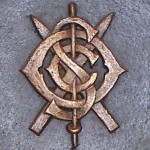The Ottawa Ski Club was formed in 1910 and went bankrupt in 1989. Between those dates Gatineau Park and Camp Fortune came into being. The OSC was intimately involved, as these documents show.
Contents of This Page
- Searching and Browsing the Newsletters
- Other Archives
- The Flow of the Newsletters
- You Can Help
- My Version of The History of the Ottawa Ski Club
Searching and Browsing the Newsletters
The newsletters are posted as PDFs. I’ve set up a Google custom search of the PDFs. This is imperfect though, as explained below under You Can Help. The list of dates at the right link to the PDFs individually so you can browse that way too. Collectively they add up to half a gig of data so please don’t just download the whole bunch for your own personal collection; it eats up bandwidth that I have to pay for. If you must have a full set, contact me and we’ll work something out.
Other Archives
After collecting these PDFs I have shared them with the Ottawa Public Library, the City of Ottawa Archives and the Gatineau Valley Historical Society whose websites may prove more durable than mine over the decades. At this time I haven’t seen them appear online at those sites, but… The logic in these sharings is that (i) OSC was obviously populated by Ottawans and the Ottawa Public Library contains the Ottawa Room which specializes in things historical and local; (ii) Ditto the City Arcives; (iii) GVHS includes things historical within Gatineau Park and as noted, the OSC were intimately associated with the Park.
The Flow of the Newsletters
The OSC was formed in 1910 but at first was such a small group that they required no newsletters. World War I ran from 1914 to 1918 and also put a damper on membership and thus generation of documentation. That’s not to say there were no documents; I just haven’t been able to get my hands on any.
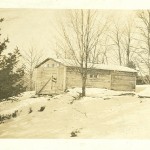 The earliest document I have here is circa January 1, 1921 and speaks about a “hike” (though it would be on skis) to inaugurate a lodge at Pink Lake (that’s it on the left, click to enlarge). A lodge had also just been purchased at Camp Fortune (picture below). These first newsletters are simple typed sheets.
The earliest document I have here is circa January 1, 1921 and speaks about a “hike” (though it would be on skis) to inaugurate a lodge at Pink Lake (that’s it on the left, click to enlarge). A lodge had also just been purchased at Camp Fortune (picture below). These first newsletters are simple typed sheets.
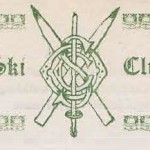 The 1923/24 ski season saw the introduction of a handsome letterhead, though it didn’t last even through that entire winter. Ads also became more prominent.
The 1923/24 ski season saw the introduction of a handsome letterhead, though it didn’t last even through that entire winter. Ads also became more prominent.
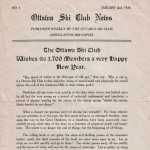 January 1926 brought a multi-page format. Up to then the newsletter had been a single sheet that varied in length and had become double-sided over time. This new format was printed on larger sheets that were folded and had to be cut & assembled into a booklet after the recipient received them in the mail. This must have confused many people because it merited an article that appears under the title The Last Word in Puzzles in the February 24, 1926 edition. The author is identified as M. T Head (empty head) and gives a hint at the warmth and humour club members shared and that shines through the decades from various increasingly crackly pages.
January 1926 brought a multi-page format. Up to then the newsletter had been a single sheet that varied in length and had become double-sided over time. This new format was printed on larger sheets that were folded and had to be cut & assembled into a booklet after the recipient received them in the mail. This must have confused many people because it merited an article that appears under the title The Last Word in Puzzles in the February 24, 1926 edition. The author is identified as M. T Head (empty head) and gives a hint at the warmth and humour club members shared and that shines through the decades from various increasingly crackly pages.
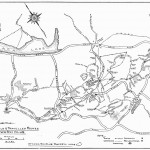 This multi-page folded format lasted until 1934 and facilitated the inclusion of a map in the January 28, 1931 edition. Maps had been mentioned before in the newsletters but this “sketch map” is the earliest copy that I could find.
This multi-page folded format lasted until 1934 and facilitated the inclusion of a map in the January 28, 1931 edition. Maps had been mentioned before in the newsletters but this “sketch map” is the earliest copy that I could find.
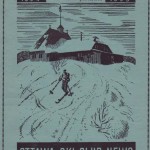 For the 1934/35 season the user-assembly stopped and the OSC News acquired a coloured cover and stapled spine.
For the 1934/35 season the user-assembly stopped and the OSC News acquired a coloured cover and stapled spine.
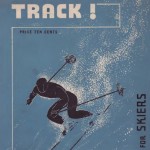 I haven’t figured out what calamity struck in the 1935/36/37 years but there seems to have been serious backslip in newsletter production. This included the folly of an attempt to rebrand the publication, calling it Track and aiming it to include other ski clubs in the region. Only one issue appeared and by January 1938 the old coloured covered version of the OSC News had reappeared.
I haven’t figured out what calamity struck in the 1935/36/37 years but there seems to have been serious backslip in newsletter production. This included the folly of an attempt to rebrand the publication, calling it Track and aiming it to include other ski clubs in the region. Only one issue appeared and by January 1938 the old coloured covered version of the OSC News had reappeared.
 1939/40 newsletters sported a glossy photographic cover for the first time but times had changed by 1941/42 the series of newsletters that had accumulated – sometimes weekly – for the previous 20 years, was replaced by a single yearbook. These yearbooks continued until 1961/62. After that there returned a less regular series of newsletters petering out in the mid 1970s.
1939/40 newsletters sported a glossy photographic cover for the first time but times had changed by 1941/42 the series of newsletters that had accumulated – sometimes weekly – for the previous 20 years, was replaced by a single yearbook. These yearbooks continued until 1961/62. After that there returned a less regular series of newsletters petering out in the mid 1970s.
You Can Help
The collection of old OSC newsletters has been assembled from various sources. In particular I’d like to thank the Canadian Ski Museum and the City of Ottawa Archives. Although this digital collection represents a more complete set than any known to be existing in original paper, it still has gaps. If you know of OSC newsletters not included here, please contact me and I’ll arrange to scan them.
The PDFs have been run through an OCR so to some degree they are text-searchable. But OCR isn’t perfect, particularly when images are poor and when words aren’t in their internal dictionaries. It’s mind numbing labour to comb through documents and correct the OCR mistakes, but if anyone is keen to do that I’d be happy to work with them to make the text-searchability of the archive better.
My Version of The History of the Ottawa Ski Club
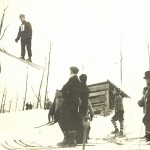 The Ottawa Ski Club was officially organized in 1910 by a handful of ski jumping crazies.They first set up ski jumps in Rockliffe Park. Here we see Sigurd Lockeberg (one of the chief crazies) flying off a modest little jump. This insanity lead to a jumping tower 145 feet tall within only 4 years. Jumping events drew thousands of spectators.
The Ottawa Ski Club was officially organized in 1910 by a handful of ski jumping crazies.They first set up ski jumps in Rockliffe Park. Here we see Sigurd Lockeberg (one of the chief crazies) flying off a modest little jump. This insanity lead to a jumping tower 145 feet tall within only 4 years. Jumping events drew thousands of spectators.
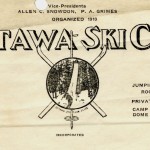 Justifiably proud of this construction it’s image appeared on OSC letterhead for a while. The tower blew down one windy day and the Ottawa Improvement Commission disallowed its reconstruction. This seems somehow an early example of a pattern of tension between Ottawa area outdoor enthusiasts and what is now the NCC (the Ottawa Improvement Commission in 1927 became the Federal District Commission and in 1959 became the National Capital Commission).
Justifiably proud of this construction it’s image appeared on OSC letterhead for a while. The tower blew down one windy day and the Ottawa Improvement Commission disallowed its reconstruction. This seems somehow an early example of a pattern of tension between Ottawa area outdoor enthusiasts and what is now the NCC (the Ottawa Improvement Commission in 1927 became the Federal District Commission and in 1959 became the National Capital Commission).
In 1914 the jumping crazies were joined by a contingent of what were then known as ski-runners. Today we’d call them classic style cross-country skiers. The sport was new enough that it was spelled ski-ing.
Ski-runners were not content to splatter themselves onto the ice of the Ottawa River, they wanted instead to range far and wide. There are references to the wilds of Sandy Hill and the East Templeton Hills (the hills east of the Gatineau River). Importantly though there were the Gatineau Hills.
The sport was so new that they hadn’t yet figured out that using two poles instead of one might be a good idea; this was figured out by roughly 1920. You can see in both the logo at the head of this page, and the letterhead above, the use of a single pole. There are also references to having to climb dozens of fences while out ski-running. This is a clue to the fact that much of the ski-ing was over open farm fields. This would have made it easier to ski with a 9 foot ski-pole than trying to schuss through the trees.
 One ski-runner named Charles Mortureux was particularly keen. He was too old to go to the First World War but young enough to scout out trails up beyond farmers’ fields and into the Gatineau Hills. Low and behold, there was room there for the ski jumping crazies to build their ski jumps. In 1920 he bought a little shack from Garrett Fortune and that became the first Camp Fortune Lodge.
One ski-runner named Charles Mortureux was particularly keen. He was too old to go to the First World War but young enough to scout out trails up beyond farmers’ fields and into the Gatineau Hills. Low and behold, there was room there for the ski jumping crazies to build their ski jumps. In 1920 he bought a little shack from Garrett Fortune and that became the first Camp Fortune Lodge.
The ski-runners had already established a network of trails and places to stay and this continued to grow as skiing continued to evolve.With the installation of ski tows skiing broke into three branches (jumping, cross-country, and alpine).
During the 1920s and 1930s the Ottawa Ski Club brought thousands of people into the winter woods where almost none had gone before.
Created in 1934 the Federal Woodlands Preservation League is generally (and properly) credited with doing the dog-work required to convince the bureaucracy to create Gatineau Park. However, as can be seen in these newsletters the Ottawa Ski Club had begun advocating for forest protection back in 1927. In 1933 they created the Ottawa Ski Club Forest Preservation Society whose efforts were soon subsumed by the FWPS.
The OSC continued skiing in all three of its styles after Gatineau Park was established and for years required skiers of all types to try the other two in their ski lessons or competitions. The Ski-Meister event, combining the styles, survived on after OSC went bankrupt. This is the reason that the network of cross country ski trails in Gatineau Park is thickest surrounding a downhill ski centre. Believe it or not, the trail network used to be much more dense in the area.
Eventually the disciplines of skiing grew apart and the jumping towers were taken down. More and more focus in the latter newsletters is given to alpine skiing until the newsletters peter out altogether. Interest in cross-country skiing saw a resurgence in the 1970s but there was already enough separation between adherents that many xc-skiers didn’t see the need to join OSC and the gap widened.
During this evolution the youth volunteer crew evolved too. Originally it was the Night Riders of the Canyon who cleared trails in the fall and kept them skiable during the season. As alpine skiing emerged the Night Riders “groomed” the hills manually (how does one put that exactly? It wasn’t by hand, it was by foot. They themselves called it cross-checking,* in reference to the pattern their skis made in the snow as they tramped it down – I’ve heard it called herringbone). This desertion of the trails by the Night Riders necessitated the creation of the Trail Riders, a second group.
Alas in the late 1980s the OSC ran into financial difficulties and folded. The NCC took over the land and continued operation of Camp Fortune through agreements with private operators. Dedicated Trail Riders tried to continue their labours of love on the trails but the pattern seen back when the Ottawa Improvement Commission outlawed the jump at Rockcliffe Park seemed to persist and the Riders and NCC couldn’t see eye to eye.
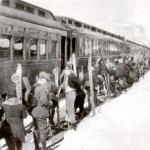 Thus endith a glorious chapter. I wax nostalgic as I read about the old trails. But something’s lost and something’s gained. The OSC was a private club and only allowed those to ski who could pay. There were lots who couldn’t. Also, when imagining the carefree laughter of the packed ski bus or train, don’t forget the cigarette smoke so thick you could hardly see the length of the thing.
Thus endith a glorious chapter. I wax nostalgic as I read about the old trails. But something’s lost and something’s gained. The OSC was a private club and only allowed those to ski who could pay. There were lots who couldn’t. Also, when imagining the carefree laughter of the packed ski bus or train, don’t forget the cigarette smoke so thick you could hardly see the length of the thing.
* Michael MacConaill wrote to say “Cross-checking was stamping down snow by a modified side-step, moving skis parallel and overlapping the traces. This was the standard way of compacting jump outruns, and was also used by the Trail Riders on the outrun of the steeper hills. The main descent could be tracked, but since skiers tended to wobble on a rising outrun, a broad tamped trail was so created.”

